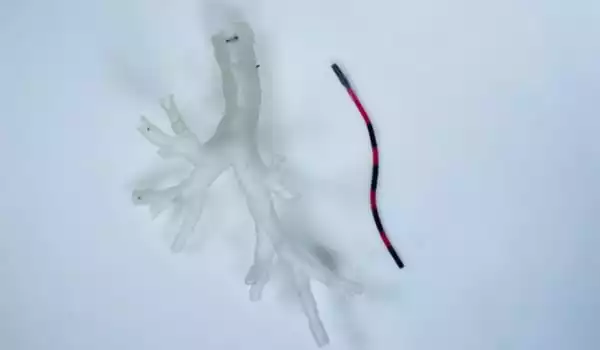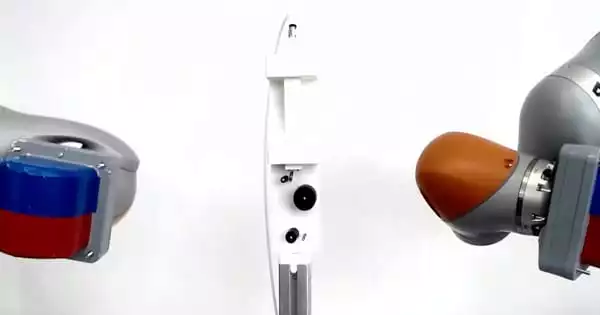Engineers and scientists have created a proof of concept for a robot that can reach some of the smallest bronchial tubes in the lungs in order to collect tissue samples or administer cancer medication. It’s called a magnetic tentacle robot, and it’s only 2 millimeters in diameter, or roughly twice the size of the tip of a ballpoint pen. Magnets on the patient’s exterior will guide the tentacle robot into position.
The gadget was created by a team of engineers, scientists, and physicians at the University of Leeds’ STORM Lab, which is pioneering the use of robotic systems to help with endoscopy and catheter procedures, in which a fine tube is put into the body. The researchers’ findings were published in the journal Soft Robotics.
Laboratory testing with a 3-D replica of a bronchial tree generated from anatomical data served as proof of concept. The device’s efficiency in navigating lungs retrieved from a cadaver will be investigated in the next round of the research.
A magnetic tentacle robot or catheter measuring 2 millimetres in length and whose shape can be magnetically controlled to conform to the bronchial tree anatomy can reach most areas of the lung, making it an important clinical tool in the investigation and treatment of possible lung cancer and other lung diseases. Our device employs an autonomous magnetic navigation system, which eliminates the requirement for patients to be X-rayed during the surgery.
Professor Pietro Valdastri
Limits of existing technology
Currently, clinicians utilize a bronchoscope to examine the lungs and airways. The process entails inserting a flexible tube-like tool, roughly 3.5 to 4 millimetres in diameter, through the nose or mouth and into the bronchial tubes. Because of its small size, the bronchoscope can only reach the higher levels of the bronchial tree.
To get deeper into the lungs, a catheter or thin tube with a diameter of around 2 millimetres is introduced through the bronchoscope and into the smaller tubes of the lungs. However, clinicians are limited in their ability to move a bronchoscope, making it difficult to route the tool and the catheter to where they are required. The magnetic tentacle robot, on the other hand, has been designed to be far more maneuverable and has a robotic guiding system that is tailored to each treatment.
Professor Pietro Valdastri, Director of the STORM Lab and the research’s supervisor, stated: “A magnetic tentacle robot or catheter measuring 2 millimetres in length and whose shape can be magnetically controlled to conform to the bronchial tree anatomy can reach most areas of the lung, making it an important clinical tool in the investigation and treatment of possible lung cancer and other lung diseases. Our device employs an autonomous magnetic navigation system, which eliminates the requirement for patients to be X-rayed during the surgery.”

Innovative technology
The study team had to overcome two significant hurdles in order to construct the robotic system. To begin, they needed to create a device that was compact, flexible, and capable of navigating the twists and turns of the bronchial tree anatomy.
Second, they need an autonomous system to guide the magnetic tentacle robot into position, eliminating the requirement for a doctor to manually manipulate an instrument into place, which frequently involves the patient being exposed to x-rays and can be technically demanding for medical staff.
Small and flexible robot
To lower the size of the robot while maintaining controllability of motion, the researchers built it out of a number of interconnecting cylindrical segments, each 2 millimetres in diameter and roughly 80 millimetres in length. The segments were made of a soft elastomeric or rubber-like substance that had been impregnated with small magnetic particles.
Because of the existence of magnetic particles, the interconnected segments can move somewhat autonomously under the influence of an external magnetic field. The end product is a magnetic tentacle robot that is very flexible, shape shiftable, and small enough to avoid snagging on anatomical structures in the lungs.
Guidance system
Magnets positioned on robotic arms on the patient’s outside would be used to guide the device into the lungs in a procedure that would be customized for each treatment. Pre-operative images of a patient’s lungs are used to plot the path through the bronchial tree, which is then programmed into the robotic system. As the magnets outside the patient move, they exert forces on the magnetic particles in the catheter segments, causing them to change form or direction, allowing the robot to be maneuvered through the lungs and to a worrisome lesion site.
Once at the desired place, the robot is utilized to collect a tissue sample or to administer treatment. It could be several years before “magnetic tentacle” technology is available in hospitals. The STORM lab at the University of Leeds is changing the way endoscopic and catheter investigations are done.
They developed a prototype of a low-cost endoscope (used to examine the upper gastrointestinal tract) that might be utilized in low- to middle-income nations where access to pricey equipment is a barrier to screening programs.
Magnetic technology is also at the heart of a robotic colonoscopy device that is easier to use for personnel and gentler on patients. The STORM lab is a component of the Leeds Centre for Cancer Research, which opened earlier this year.





